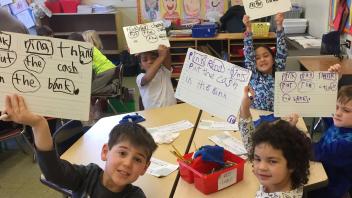How do you teach spelling words? Many teachers teach spelling by giving students a list on Monday and a test on Friday with practice in between.
This type of drill and practice has earned traditional spelling instruction a reputation for being boring. That there is no big picture and no ultimate goal makes it all the more tedious. As soon as one spelling list is tested, another list takes its place.
Now there is an alternative to traditional spelling instruction called “Word Study,” which is not based on the random memorization of words. A word study program is a cohesive approach that addresses word recognition, vocabulary, and phonics as well as spelling (Zutell, 1992).
What is word study?
Word study provides students with opportunities to investigate and understand the patterns in words. Knowledge of these patterns means that students needn’t learn to spell one word at a time.
Take, for example, the difference between “hard c” (as in cat) and “soft c” (as in cell). After collecting many words containing the letter “c,” students discover that “c” is usually hard when followed by consonants (as in clue and crayon) and the vowels “a,” “o,” and “u” (as in cat, cot, and cut). In contrast, “c” is usually soft when followed by “i”, “e,” and “y” (as in circus, celery, and cycle).
Of course, for every rule there are exceptions that threaten the rule. Students learn, though, that spelling patterns exist and that these patterns help to explain how to spell, read, and write words.
Word study is also designed to build word knowledge that can be applied to both reading and spelling (Henderson, 1992; Zutell, 1998). Because it is closely tied to reading instruction, it also develops students’ abilities in phonics, word recognition, and vocabulary (Baker, 2000).
How is word study taught?
There are distinct stages in students’ spelling development (Henderson, 1981). Students at different stages attend to and represent different features in their spelling (Templeton, 1991).
Word study is based on the notion that where a student is in his or her spelling development can serve as a guide for instruction. At the start of a word study program, teachers use a spelling inventory to determine which stage of spelling development each student is at and then groups students for instruction (Bear, et al., 2000). Once groups are created, teachers develop “differential instruction” based on the stage of development each group of students has achieved (Bear & Barone, 1989).
Instruction has to be deliberately sequenced by the teacher so students will get instruction that will propel their development. Teachers select a group of words that demonstrate a particular spelling pattern and sequence these patterns to match children’s development (Templeton, 1991). Because the pace of children’s progression through the stages varies, rarely would all the students in a class be studying the same list of words (Barnes, 1986).
To implement word study effectively, teachers and students alike must become word detectives, engaged in an ongoing attempt to make sense of word patterns and their relationships to one another. Spelling “rules” are not dictated by the teacher for students to memorize. Rather, spelling patterns and generalizations are discovered by students.
Teaching strategies
In word study, teachers encourage students to compare and contrast features in words. One common method for doing so is by having students sort words. When sorting, students use their word knowledge to separate examples that go together from those that don’t.
In addition to sorting, students may hunt for words in their reading and writing that fit the pattern being studied, may construct a word wall illustrating examples of the different patterns studied, may keep a word study notebook to record the known patterns and their new understandings about words, or may play games and activities to apply their word knowledge (Bear et al., 2000).
A cycle of instruction for word study might include the following:
- introduce the spelling pattern by choosing words for students to sort
- encourage students to discover the pattern in their reading and writing
- use reinforcement activities to help students relate this pattern to previously acquired word knowledge
Teachers then test students’ pattern knowledge rather than their ability to memorize single words. For example, a teacher might have students work with twenty words during a word study cycle and then randomly test students on ten of those words. For students studying the -at family, a teacher might include the word “vat” on the spelling test even though it wasn’t on the initial spelling list – this allows the teacher to see if students are able to transfer their knowledge of the “at” chunk to a new word they haven’t seen before.
Adapted and excerpted from: Leipzig, D. H. (2000). Actions teach louder with words: How and what experienced teachers learn about embedded word study from classroom practice and an inquiry group. (Unpublished doctoral dissertation.) University of Maryland, College Park, MD.
